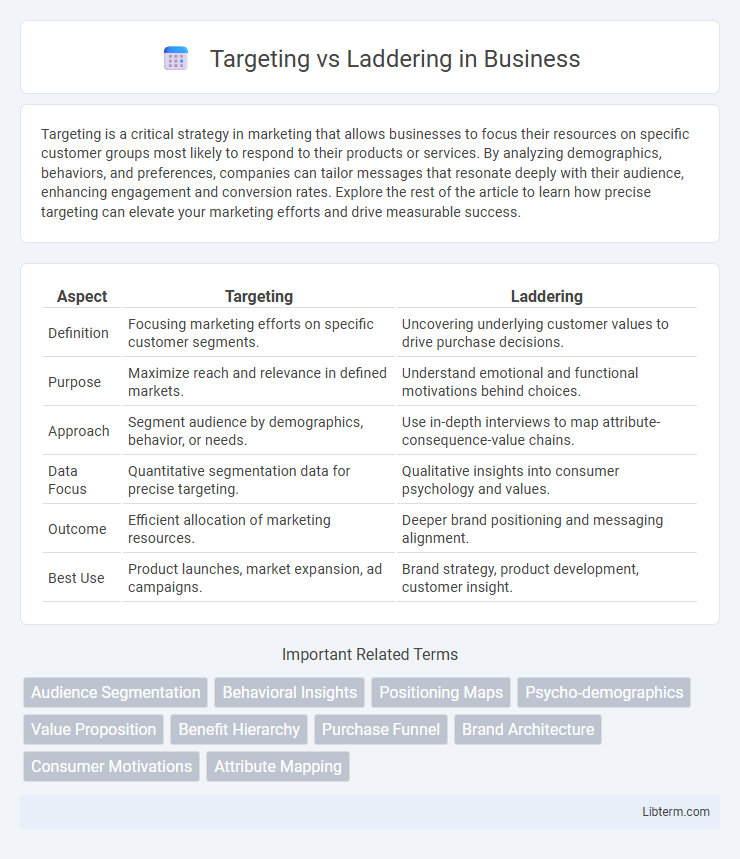Targeting is a critical strategy in marketing that allows businesses to focus their resources on specific customer groups most likely to respond to their products or services. By analyzing demographics, behaviors, and preferences, companies can tailor messages that resonate deeply with their audience, enhancing engagement and conversion rates. Explore the rest of the article to learn how precise targeting can elevate your marketing efforts and drive measurable success.
Table of Comparison
| Aspect | Targeting | Laddering |
|---|---|---|
| Definition | Focusing marketing efforts on specific customer segments. | Uncovering underlying customer values to drive purchase decisions. |
| Purpose | Maximize reach and relevance in defined markets. | Understand emotional and functional motivations behind choices. |
| Approach | Segment audience by demographics, behavior, or needs. | Use in-depth interviews to map attribute-consequence-value chains. |
| Data Focus | Quantitative segmentation data for precise targeting. | Qualitative insights into consumer psychology and values. |
| Outcome | Efficient allocation of marketing resources. | Deeper brand positioning and messaging alignment. |
| Best Use | Product launches, market expansion, ad campaigns. | Brand strategy, product development, customer insight. |
Introduction to Targeting and Laddering
Targeting involves identifying and segmenting specific consumer groups to tailor marketing efforts effectively, optimizing reach and engagement based on demographic, psychographic, and behavioral data. Laddering is a qualitative research technique used to uncover deeper consumer motivations by linking product attributes to personal values through a series of probing questions. Combining targeting with laddering enhances marketing strategies by aligning precise audience segments with their underlying emotional drivers, driving higher conversion rates.
Defining Targeting: Purpose and Methods
Targeting involves selecting specific audience segments based on demographics, behaviors, and preferences to maximize marketing effectiveness. The purpose of targeting is to tailor messages and offers that resonate with high-potential customers, thereby increasing engagement and conversion rates. Common methods include demographic analysis, psychographic profiling, and data-driven segmentation using customer analytics and market research.
Understanding Laddering: A Step-by-Step Approach
Laddering is a step-by-step approach used in consumer research to uncover the underlying values behind purchasing decisions by linking product attributes to personal motivations. The process involves identifying specific product features, exploring the consequences of those features, and revealing the core values that drive consumer behavior. This method provides deeper insights compared to targeting by focusing on motivational hierarchies rather than demographic segments.
Key Differences Between Targeting and Laddering
Targeting involves selecting specific consumer segments based on demographic, psychographic, or behavioral criteria to tailor marketing efforts effectively. Laddering, however, is a qualitative research technique that uncovers the underlying values and motivations driving consumer behavior through in-depth interviews and hierarchical value mapping. The key difference lies in targeting's focus on group segmentation for strategic marketing, while laddering concentrates on understanding the personal emotional connections influencing individual purchase decisions.
Benefits of Targeting in Marketing Strategies
Targeting in marketing strategies allows businesses to focus resources on specific consumer segments with the highest potential for conversion, improving return on investment and reducing marketing waste. By tailoring messages and offers to well-defined audiences, companies enhance customer engagement and build stronger brand loyalty. Precise targeting also enables data-driven decision-making, optimizing campaign performance and driving sustainable growth.
Advantages of Laddering for Consumer Insights
Laddering uncovers deep consumer motivations by linking product attributes to personal values, offering richer insights than traditional targeting methods. This approach reveals emotional drivers and decision-making processes, enabling marketers to create more resonant and personalized campaigns. Utilizing laddering enhances understanding of consumer behavior, leading to improved product positioning and stronger brand loyalty.
When to Use Targeting vs. Laddering
Targeting is most effective when you have a clearly defined audience segment and want to tailor messages or products specifically to their needs and preferences. Laddering is better suited for uncovering deeper motivations and values behind consumer choices, often used during exploratory research or when developing emotional branding strategies. Use targeting to optimize marketing efficiency with known demographics and laddering to gain insights for innovation and brand positioning.
Practical Applications in Real-World Scenarios
Targeting involves selecting specific customer segments based on demographics, behaviors, or needs to optimize marketing efforts and increase conversion rates. Laddering uncovers the underlying values and motivations driving consumer behavior by exploring means-end chains, enabling the development of emotionally resonant messaging and product positioning. In practical applications, businesses use targeting to efficiently allocate resources while integrating laddering insights to craft compelling campaigns that strengthen brand loyalty and customer engagement.
Common Challenges and Solutions
Targeting often faces challenges such as audience misidentification and inefficient resource allocation, while laddering struggles with uncovering true consumer motivations and translating insights into actionable strategies. Common solutions involve employing advanced data analytics and machine learning to refine target segments for precision marketing and using in-depth qualitative research methods, like in-depth interviews, to enhance laddering effectiveness. Integrating both approaches can optimize customer understanding and improve campaign outcomes by balancing broad market focus with deep psychological insights.
Conclusion: Integrating Targeting and Laddering
Integrating Targeting and Laddering enhances marketing strategies by combining precise audience segmentation with deep understanding of consumer motivations. Targeting identifies specific demographic or behavioral groups, while Laddering uncovers the underlying values driving their choices. Together, they create a comprehensive approach that aligns messaging with both who the customers are and why they make decisions, optimizing campaign effectiveness.
Targeting Infographic

 libterm.com
libterm.com